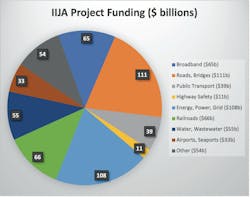Year-End Fiber Forward Learnings
This year has been one of surprises and challenges that are often connected. Unlike years in the past, the news was not new technology or applications, it was all about funding fiber optic infrastructure projects. The US government passed the Infrastructure Investment and Jobs Act (IIJA) where one part of it, the Broadband Equity, Access and Deployment (BEAD) program, sets aside ~$43 billion to fund building broadband in unserved and underserved areas.
This one program is making waves—perhaps better to say a tsunami—in the communications world. Let’s look at some of its impact on us.
The BEAD program is managed by the National Telecommunications and Information Administration (NTIA). In their announcement of the BEAD program funding, they clearly state, “With respect to the deployment of last-mile broadband infrastructure, the Program prioritizes projects designed to provide fiber connectivity directly to the end user” and “NTIA has determined that ‘Priority Broadband Projects’ are those that use end-to-end fiber-optic architecture. Only end-to-end fiber will ‘ensure that the network built by the project can easily scale speeds over time to ... meet the evolving connectivity needs of households and businesses’ and ‘support the deployment of 5G, successor wireless technologies, and other advanced services.’”
They are saying what we in the field have been saying for decades; wireless and DSL cannot compete with fiber optics. Now everybody is talking about fiber like it’s some newfangled invention instead of a technology that some of us have been working with for nearly half a century.
"With the shortage of competent fiber techs, contractors are subcontracting and sub-subcontracting to the lowest bidders. It’s not a coincidence that underground damages can occur when this happens."
Companies Die From Indigestion More Often Than Starvation
Interestingly, the total amount of BEAD spending will likely be $60 billion because it requires local matching funds. Not surprisingly, we’re already seeing signs of what’s coming. Fiber optic cable delivery times are long and getting longer—mostly from 5G and data centers to date. In response, manufacturers are adding equipment and building factories. Now project management must plan farther in advance to ensure components arrive on time.
We also have a shortage of qualified fiber techs, so much so that the FOA has been contacted by state agencies looking for help finding fiber optic contractors to bid on these billion-dollar jobs. With all this new funding for fiber jobs, we need to get started recruiting and training new fiber techs.
Fiber Techs Must Upgrade Credentials
The BEAD funding document also has another zinger, “Use of an appropriately credentialed workforce (i.e., satisfying requirements for appropriate and relevant pre-existing occupational training, certification, and licensure).”
With the shortage of competent fiber techs, contractors are subcontracting and sub-subcontracting to the lowest bidders. It’s not a coincidence that underground damages can occur when this happens. As an example, contractors have broken gas mains twice within a mile of my office. Unintentionally, landscape contractors reassigned to underground construction jobs can easily cut buried fiber optic cables.
Today’s techs can step up to the challenge and become highly sought after when they upgrade their skills and get certified. Experienced techs can use the FOA’s free “Work-to-Cert” program and study online to take the FOA CFOT® certification exam. Novices should take a course to learn the basics but if that’s not available, they can join the FOA “OJT-to-Cert” program and study online while they learn on the job.
Thankfully, the BEAD program includes funding for training and certification. Experienced organizations like the FOA are already working with state agencies to create local training programs like the FOA did for Kentucky Wired in the Kentucky Community and Technical College System (KCTCS). This grass roots initiative recruited and trained many techs for the contractors who built the Kentucky Wired backbone—connecting all 95 counties in the state.
Our organization also works with high schools to empower STEM teachers with recruiting information about fiber optic careers. Together, the FOA and teachers can help convince students that fiber optic jobs are high tech and don’t require a degree to succeed.
The Tip of the Fiber Iceberg
When BEAD was announced, we were pleased to see the recognition that broadband Internet service and fiber optics were receiving. Equally as important is the other “infrastructure” the IIJA will fund with a trillion dollars that will require fiber optics. (See Figure 1.)
Infrastructure projects that will also require fiber optics include transportation—roads, bridges, airports, seaports, railroads, and public transit systems. Fiber optics are needed for applications in energy, electrical generation, transmission and distribution and all forms of alternative energy sources—wind, solar, hydroelectric, and geothermal. And you guessed it. Fiber optics is also used in energy exploration, extraction, refining, and distribution.
Working with municipalities, fiber optics are critical for low profile applications like monitoring and controlling water and wastewater systems as well as intelligent traffic systems, security, and education.
Undoubtedly, the $1 trillion for all those infrastructure projects will add to the size of the fiber optic market. How big it will be over the next decade is only a guess. Will the market double? Triple? We don’t know, but it will be big. And the impact on the fiber optic supply chain and workforce will likely be bigger than we can forecast as well.
Skilled labor is the missing piece. We need to address this as an industry in 2023.
About the Author
Jim Hayes
Fiber Optic Expert
Jim Hayes is the Fiber Optic Expert columnist for ISE Magazine. He is a lifelong techie who has been involved in the fiber optic industry since the late 1970s. He founded one of the world's first fiber optic test equipment companies, FOTEC, which was acquired by Fluke in 2000, and he was a co-founder of the Fiber Optic Association (FOA), the international professional society of fiber optics, in 1995.
Jim is a writer and trainer and the President of FOA. He is the author of nine books on fiber optics and cabling and writes for several magazines.
Jim and his wife, Karen, who is the GM of the FOA, have traveled the world for the FOA helping set up schools to train the workers who design, build, and operate today's communications networks. The FOA offers nearly 1,000 pages of online technical materials, over 100 videos, and two dozen free self-study courses online.
For more information, email [email protected] or visit www.jimhayes.com.
To learn more about The Fiber Optic Association, visit www.thefoa.org. Follow them on Facebook: FiberOpticAssociation, LinkedIn: company/the-fiber-optic-association-inc-foa, and YouTube: user/thefoainc.


